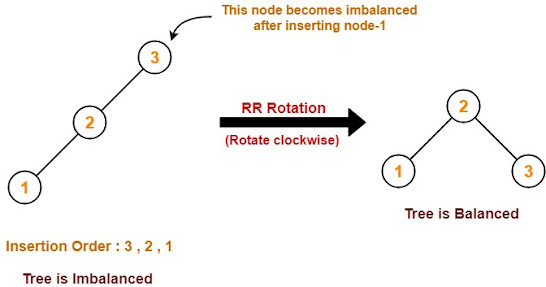AVL tree vs RB tree with applications
AVL tree vs RB tree with applications
What is AVL Tree?
In 1962, GM Adelson
- Velsky and EM Landis invented the AVL Tree. The tree is named AVL after its
creators.
The AVL Tree is a
height balanced binary search tree in which each node has a balance factor that
is calculated by subtracting the height of its right sub-tree from the height
of its left sub-tree.
If the balance
factor of each node is between -1 and 1, the tree is said to be balanced;
otherwise, the tree is unbalanced and must be balanced.
Balance
Factor (k) = height (left(k)) - height (right(k))
If balance factor of any node is 1, it means that the left
sub-tree is one level higher than the right sub-tree.
If balance factor of any node is 0, it means that the left
sub-tree and right sub-tree contain equal height.
If balance factor of any node is -1, it means that the left sub-tree is one level lower than the right sub-tree.
The figure below depicts an AVL tree. We can see that the
balance factor for each node is between -1 and +1. As a result, it is an
example of an AVL tree.
AVL Rotations:
If the balancing
factor is not -1,1,0, it will balance itself by rotating. An AVL tree can
balance itself by performing the four rotations listed below.
- Left rotation
- Right rotation
- Left-Right rotation
- Right-Left rotation
The first two
rotations are single rotations, followed by double rotations. A tree of at
least height 2 is required to have an unbalanced tree. Let's break them down
one by one using this simple tree.
Case-01:
Case-02:
Case-03:
Case-04:
What is RB Tree?
A self-balancing binary search tree with a Red Black Tree is a
type of self-balancing binary search tree. Rudolf Bayer invented it in 1972 and
dubbed it "symmetric binary B-trees."
A red-black tree is a Binary tree in which each node has a
color attribute, either red or black. By inspecting the node colors on any
simple path from the root to a leaf, red-black trees ensure that no such path
is more than twice as long as any other, ensuring the tree's overall balance.
Properties
of Red-Black Trees:
A red-black tree is a binary
search tree which has the following red-black properties:
Basic red-black tree with the nodes added: |
Differences between the Red-Black tree and AVL tree:
1. Searching-
Because Red Black Trees are roughly balanced, they do not
provide efficient searching. AVL trees, on the other hand, provide efficient
searching because they are strictly balanced trees.
2. Insertion and Deletion -
Insertion and deletion are simple because only a few rotations are required to balance the tree in insertion or deletion, whereas Insertion and Deletion are complex in the AVL tree because multiple rotations are required to balance the tree.
3. Node color-
We color the nodes of the red black tree either red or black, but no color is required in the AVL tree.
4. Balance factor-
It does not contain any balance factor. It
stores only one bit of information that denotes either Red or Black colour of
the node whereas in AVL each node has a balance factor whose value can be
1, 0, or -1. It requires extra space to store the balance factor per node.
5.Strictly Balanced-
Red-black trees are not strictly balanced but
AVL trees are strictly balanced, i.e., the left subtree's height and the height
of the right subtree differ by at most 1.
6.Tools used for balancing trees-
If the tree is not balanced, then two tools
are used for balancing the tree in a Red-Black tree:
1. Recoloring
2. Rotation
If the tree is not balanced, then one tool
is used for balancing the tree in the AVL tree:
1. Rotation
Application:
1. AVL
TREES:
1. AVL trees are mostly
used for in-memory sorts of sets and dictionaries.
2. AVL trees are also used extensively in database applications in which
insertions and deletions are fewer but there are frequent lookups for data
required.
3. It is used in
applications that require improved searching apart from the database
applications.
2. RB
TREES:
1. Most of the self-balancing
BST library functions like map and set in C++ use Red-Black Tree.
2. It is used to implement
CPU Scheduling Linux. Completely Fair Scheduler uses it.
3. Besides they are used
in the K-mean clustering algorithm for reducing time complexity.
4. Moreover, MySQL also
uses the Red-Black tree for indexes on tables.
Conclusion:
In the case of the Red-Black tree, the insertion and deletion
operations are efficient. If the tree gets balanced through the recoloring,
then insertion and deletion operations are efficient in the Red-Black tree.
In the case of the AVL tree, the searching operation is
efficient as it requires only one tool to balance the tree.








Interesting
ReplyDeleteVery informative 👍
ReplyDeleteNice work 👏
ReplyDeleteGreat 👍
ReplyDeleteGood Informative blog
ReplyDeleteAmazing Content
ReplyDeleteRelly liked it
Good work
ReplyDeleteAmazing
ReplyDeleteNice work
ReplyDeleteKeep it up guys
ReplyDeleteNice content
ReplyDeleteVery informative!!!
ReplyDeleteNice information
ReplyDeleteGood work guys
ReplyDeleteNice explanation guys
ReplyDeleteInformative, thanks
ReplyDeleteNice information ✌️
ReplyDeleteA great compendium of what I was looking for.. 💯
ReplyDeleteNice one 👍
ReplyDeleteWell done 💯💯
ReplyDeleteVery helpful����
ReplyDeletegoood work
ReplyDeleteVery Informative !!
ReplyDeleteNice content
ReplyDeleteNice explanation!!!
ReplyDeleteVery informative 👍
ReplyDeleteReally awesome!
ReplyDelete